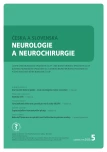Supracerebellar transtentorial approach
Authors:
R. Bartoš 1,2; M. Sameš 1; A. Malucelli 1; A. Hejčl 1; D. Ospalík 3; D. Bejšovec 4; V. Němcová 2
Authors‘ workplace:
Neurochirurgická klinika Univerzity, J. E. Purkyně, Masarykova nemocnice, KZ a. s., Ústí nad Labem
1; Anatomický ústav 1. LF UK, Praha
2; Neurologické oddělení, Masarykova, nemocnice, KZ a. s., Ústí nad Labem
3; Klinika anesteziologie, perioperační, a intenzivní medicíny Univerzity, J. E. Purkyně, Masarykova nemocnice, KZ a. s., Ústí nad Labem
4
Published in:
Cesk Slov Neurol N 2022; 85(5): 399-404
Category:
Short Communication
doi:
https://doi.org/10.48095/cccsnn2022399
Overview
Aim: The aim of this work was a retrospective evaluation of the safety of the supracerebellar transtentorial approach in our patient series. It represents a technically challenging approach, which we used during surgeries of the posterior and medial mediotemporal area, lateral mesencephalon and posteromedial thalamus. Materials and methods: We evaluate the series of our 8 patients, which we operated on using the supracerebellar transtentorial approach during 2013–2021. In one case, we dealt with anaplastic astrocytoma, 3× with glioblastoma multiforme primary surgery, 1× with diffuse midline H3K27M glioma, 1× with glioblastoma multiforme recurrence surgery, 1× with low-grade glioma surgery and once we operated using this approach an acutely bleeding cavernoma of the lemniscal trigone of the mesencephalon. All our patients were operated on in a semisitting position. Results: The thirty-day mortality rate of our series is zero. In case of a patient with diffuse midline H3K27M glioma which was primarily operated on in a bad neurological condition, we had to perform early revision surgery using the same approach due to residual tumor hemorrhage. In case of our first patient with extensive mediotemporal anaplastic astrocytoma, we had to add the suboccipital approach for resection radicality increase early after the first phase of surgery; after the surgery, he had superior quadrantanopsia. In one patient’s case, ischemia of the occipital lobe occurred due to an intraoperatively visible lesion of the posterior cerebral artery inside the glioblastoma. After surgery, hemianopsia was present. Conclusion: The approach poses a technically challenging, but concurrently safe surgical trajectory. In case of the lesions affecting the mediotemporal area, it is advantageous for its medial and posterior part, but during the resection it is possible to reach as far as the uncus and amygdala. The prerequisite condition is accurate anatomical knowledge; in our department, we prefer the semisitting position for this approach. It is important to have a sufficient cerebrospinal fluid decompression by releasing the fluid from the cisterna magna from a separate dural incision and a gentle manipulation of the vascular structures of the tentorial incisura.
Keywords:
Hippocampus – Amygdala – brain glioma – cavernoma – supracerebellar approach
Sources
1. Bartoš R, Radovnický T, Orlický M et al. Kombinovaný paramediánní supracerebellární-transtentoriální a miniinvazivní suboccipitální přístup při resekci gliomu celé délky mediobazální temporální oblasti: anatomická studie, technické poznámky a kazuistika. Cesk Slov Neurol N 2014; 77/110 (3): 353–358.
2. Teton ZE, Hendricks BK, Marotta DA et al. Transtentorial approach to parahippocampal lesions: a technically challenging approach for preserving temporal lobe structures. World Neurosurg 2020; 142: 626–635. doi: 10.1016/j.wneu.2020.07.092.
3. Baranoski JF, Bajaj A, Przybylowski CJ et al. Clip retraction of the tentorium: application of a novel technique for tentorial retraction during supracerebellar transtentorial approaches. J Neurosurg. 2020; 134 (3): 1198–1202. doi: 10.3171/2020.2.JNS192952.
4. Türe U, Harput MV, Kaya AH et al. The paramedian supracerebellar-transtentorial approach to the entire length of the mediobasal temporal region: an anatomical and clinical study. Laboratory investigation. J Neurosurg 2012; 116 (4): 773–791. doi: 10.3171/2011.12.JNS11791.
5. Lafazanos S, Türe U, Harput MV et al. Evaluating the importance of the tentorial angle in the paramedian supracerebellar-transtentorial approach for selective amygdalohippocampectomy. World Neurosurg 2015; 83 (5): 836–841. doi: 10.1016/j.wneu.2014.12. 042.
6. Serra C, Türe H, Yaltırık CK et al. Microneurosurgical removal of thalamic lesions: surgical results and considerations from a large, single-surgeon consecutive series. J Neurosurg 2020; 1–11. doi: 10.3171/2020.6.JNS20 524.
7. Serra C, Akeret K, Staartjes VE et al. Safety of the paramedian supracerebellar-transtentorial approach for selective amygdalohippocampectomy. Neurosurg Focus 2020; 48 (4): E4. doi: 10.3171/2020.1.FOCUS19 909.
8. Yonekawa Y, Imhof HG, Taub E et al. Supracerebellar transtentorial approach to posterior temporomedial structures. J Neurosurg 2001; 94 (2): 339–345. doi: 10.3171/jns.2001.94.2.0339.
Labels
Paediatric neurology Neurosurgery NeurologyArticle was published in
Czech and Slovak Neurology and Neurosurgery

2022 Issue 5
Most read in this issue
- Lumbar spine disorder – the new occupational disease
- Cenobamate
- Carotid web
- The dentate gyrus – anatomy, vascular supply, function and neuropathology
